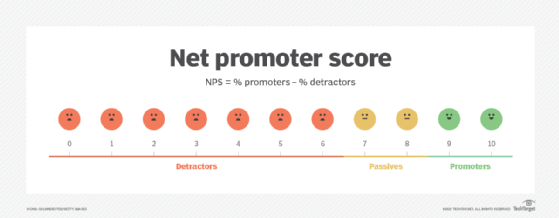Net Promoter Score (NPS)
What is Net Promoter Score?
Net Promoter Score (NPS) is a metric that organizations use to measure customer loyalty toward their brand, product or service.
Many companies use NPS as part of their customer relationship management (CRM) strategy, as the metric is easy to form and calculate. A company just has to ask its customers one question: "On a scale of 0 to 10, how likely are you to recommend us to a friend or colleague?" NPS is measured as a score from -100 to 100. Higher scores are better, as the number informs an organization how well it's perceived by its customers.
NPS is a common metric used to determine customer perception and experience. Organizations use NPS scores to help find business areas that need improvement to create better customer loyalty.
Organizations must ensure they keep NPS surveys from feeling coerced, however, and they shouldn't be the only metric used when determining customer loyalty.
How to calculate Net Promoter Score
Answers to the question "How likely are you to recommend us to a friend or colleague?" are assigned a number on a scale from 0 to 10, with 10 being the most positive. Customers are then divided into the following three categories: promoters, passives and detractors.
- Promoters (score 9-10) are the most loyal customers and may refer others to the organization or service.
- Passives (score 7-8) are satisfied yet unenthusiastic and can be swayed by more competitive options.
- Detractors (score 0-6) are unhappy and can damage a brand with negative word of mouth.
With social media, customers can easily share their thoughts on the organization's products or services.

The Net Promoter Score can be calculated by subtracting the percentage of detractors from the percentage of promoters. Another way to determine the same score is to use the following equation:
(number of promoters - number of detractors) / (number of responses) x 100
So, for example, if there are 50 promoters and 30 detractors with 100 responses, the equation would be (50-30)/(100) x 100 = an NPS score of 20.
Why is Net Promoter Score important?
NPS was first introduced in a 2003 Harvard Business Review article by Fred Reichheld titled "The One Number You Need to Grow." Reichheld felt that it was important for a company to know how many of its customers were assets and how many were liabilities. By correlating the customer's subjective response to an objective number, the metric can be used to legitimately drive a company's internal priorities.
NPS helps companies organize a methodology around improving their perception and reducing negative word of mouth or unhappy customers -- which can lead to business growth.
What can you measure with NPS?
Organizations that offer a product or service -- such as call centers, internet service providers, department stores or healthcare providers -- can use Net Promoter Scores. The metric helps them do the following:
- determine customer retention and loyalty;
- determine customer perception;
- determine customer churn; and
- monitor organization, product or service improvements.
Reichheld maintains that organizations can use the Net Promoter Score as a key performance indicator (KPI) for growth because loyalty, in his estimation, is the most important factor for generating sustainable growth. His research found that companies with a better ratio of promoters to detractors grew more quickly than their competitors when they maintained an NPS within a 50-80 overall range. Subsequent research from others has challenged that conclusion, and NPS detractors recommend that if an NPS score is used, it should be supplemented with additional questions to provide the company with insight into customer motivation so it can identify actionable items.
How to interpret NPS
Net Promoter Scores are expressed as a score from -100 to 100. A negative score occurs when a company has more detractors than promoters, and a positive score occurs when a company has the inverse. A good NPS is typically considered any score above a 0, since this means the organization has more promoters than passives or detractors. A bad NPS, likewise, is considered any score below 0.
Knowing average Net Promoter Scores by industry can help organizations understand if an individual NPS is considered good in context. For example, if the typical score in a particular industry averages around a -10, an organization's individual score of -3 wouldn't be as bad by comparison. Likewise, an NPS score of 3 would be considered worse in context when compared to an industry where the average score is 30.
How to create an NPS survey
The most basic NPS survey would include just the question "On a scale from 0 to 10, how likely are you to recommend us to a friend or colleague?" However, surveys can be supplemented with additional questions that provide more insight into customer motivations. Additional survey questions typically include the following:
- Demographic questions about age or gender. Scores may vary across demographics, so asking these questions can give a company a better idea of customer loyalty across audience segments.
- A question asking the "Reason for your score." This is normally an open-ended question asking the individual the reason behind why they gave that numerical score.
- Ask "How could we improve?"
- A question asking for permission to follow up with the customer as needed.
The survey can be sent to a customer by email or appear on a webpage or in a popup. Organizations can keep track of NPS using customer experience management or NPS software, which should be updated regularly.
Learn more about creating an NPS survey along with other customer satisfaction-based surveys.






